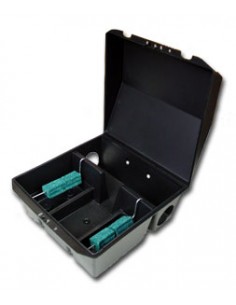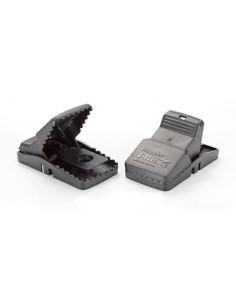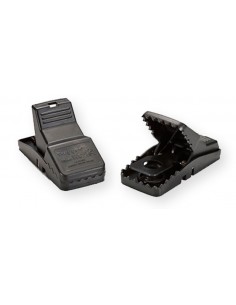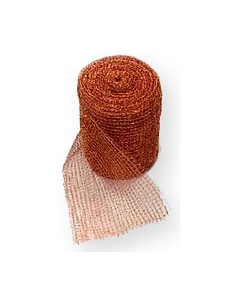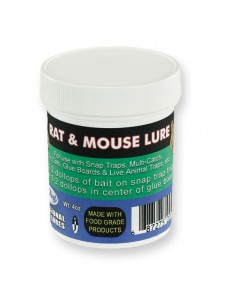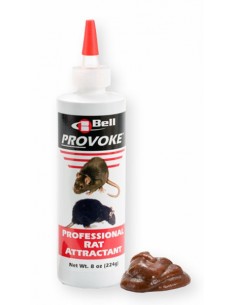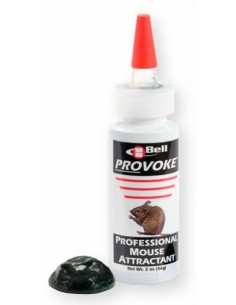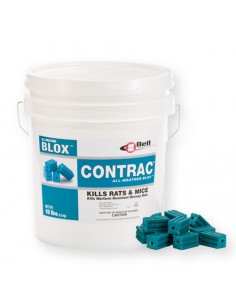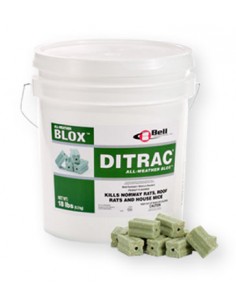How to get rid of rats and mice - learn the 3 easy steps. Whether it's a home, business, restaurant, warehouse or almost any building, the control techniques are the same. Learning the 3 basic steps of rat and mice control will save you time, money and lots of frustration.......
Step #1 - Seal Exterior Holes Larger Than a Dime
Get rid of rats & mice outdoors by not letting them in. Start by sealing all exterior holes that are larger than a dime or about 1/2" in diameter. Rats and mice can flatten themselves out and squeeze through the tiniest holes. So if you can stick your pinky finger into the hole, a rat or mouse can probably get through it. Don't be tempted to toss rat bait into the attic or garage and skip this step. It's the most important step, and if the holes are not sealed, the rats & mice will have continual access inside and out. Rats & mice are very active, territorial, and often can move from house to house looking for food, water and a place to live. The noises and messes they make may be of those that are just visiting and then leaving and "making the rounds. If you hear rats or mice or see signs such as droppings, gnaw marks or dirty smudge marks around holes where they can get in, there could be a problem.
"Sealing exterior entry points is the only way to keep rodents out. Unless you make an honest effort, they will continually go in and out looking for food and water. "
Sealing exterior entry points is the only way to permanently get rid of rats & mice. Products such as
Stuffit (copper wool), and
Pest Plug (stainless wool) are easy to use and can be cut with a pair of scissors. Simply cut off the amount needed and insert into the hole to plug it. Unless you make an honest effort at keeping rats & mice out, they will continually go in and out looking for food and water. What's worse, they don't control their urine or bowels, and will urinate and defecate on everything. A rat will leak several ounces of urine per day, and drop hundreds of fecal pellets or droppings. These serve to not only contaminate the surfaces that they come in contact with, they attract other rodents as well. So unless you seal them out and make it very difficult for them to get in, other rats & mice will soon follow the scent.
Step #2 - Place Bait Stations or Traps Around The Exterior
Get rid of rats & mice by placing bait stations or traps around the exterior of the building. Use professional quality rodent bait stations such as the
Protecta HP or bait stations with traps inside (such as the
Protecta HP with the
TREX Rat Trap) around the outside exterior wall. Rodent bait stations are usually placed every 25- 50 feet around a home or building. Using traps instead of toxic bait is safer around pets and children. It can be a lot less expensive in the long term, as the traps are reusable. All restaurants, food facilities, and bakeries are required by City Health Ordinances to have rodent stations every 25-50 feet around the exterior using either rat & mice bait or traps.
RELATED ARTICLE: The Best Rat Trap, Rat Trap Review Commercial warehouses also use them as part of their rat & mice control programs. Some large facilities use rodent stations around the exterior of the building and also around an exterior fence. It is not uncommon for larger facilities to have as many as 100 or more rodent bait stations - all outdoors as a first means of rodent defense. An average home will only require 2-3 rodent bait stations. If it's a large home with several sides or next to a creek, lake or wooded area, then more stations may be needed.
"The purpose of using rodent bait stations outdoors is to give them what they are looking for - food and shelter"
By using rodent bait stations or stations with traps outdoors, the rat and mice population can be greatly reduced which also reduces the chances of them getting indoors. Only a small percentage of rodents that get inside a building make up the outdoor population. The rest are usually hiding in some other place, such as clutter, trash, holes in the ground, etc. If bait stations or traps outdoors are kept cleaned, maintained and in working order, the chances of rodents getting indoors will be reduced. Baiting or trapping outdoors is where all rat and mice control programs start. Outdoor baiting or trapping alone won't solve rat and mice problems. Sealing up holes where they can get in is the first step. Remember - step number #1 is to seal them out, step number #2 is to place bait stations or traps outdoors around the exterior of the building. If you do this, then indoor trapping may not be necessary.
Step #3 - Trap Rats & Mice Indoors - Don't Use Poison Bait
Get rid of rats & mice indoors by trapping and not by using poison rat bait. Save the toxic bait for outdoors only. Never toss toxic rat bait into an attic or crawl space. It's easy to make a quick visit to the hardware store, buy some rat or mouse bait and start whirling packets everywhere. However, this is not a proper application and it is possible that you could create serious problems -
such as dead rodent odors and flies. What if a rodent eats the bait and then dies in the attic? What if it dies in a wall? The smell can last for weeks or even a month or more. The odor from dead rodents can be nauseating. To make matters worse, flies such as the green bottle fly WILL show up and cause a problem of their own. There is no such thing as a rat bait that makes the rodents dry out and not smell. That is an old myth. Don't believe it and don't take that chance by using rat bait indoors.
"What if a rodent eats the bait and then dies in the attic? What if it dies in a wall? The smell can last for weeks or even a month or more"
Snap traps such as the
Trex Rat Trap are the simplest and most effective way to control rodents indoors. The trick is to place the trap in an area where it is easy to get to and can be inspected - at least every other day. The single biggest mistake one can make is to set a rat trap and then leave it unattended. An unchecked trap could have no bait or could contain a dead rodent.
Related Article: How To Set Rat Traps There are several professional lures available such as
JF Oakes Rat & Mice Lure and also
Bell Provoke Attractant. Most of the time, plain old peanut butter works just fine. I won't go into all the little tricks and tips of trapping in this post, I'll blog on that later. Using 2 or more traps always works best. Sometimes you can outsmart the rats by wiring one of them open so it can't close. This teaches the rats or mice to trust the trap. It's called "pre-baiting". After a few days, unwire the trap and start trapping. If you find a dead rat or mouse in the trap, always use disposable gloves and dispose of the rodent by sealing it up in a plastic bag and tossing it into the trash.
DON'T THROW AWAY THE TRAP! A used rat trap is actually better at capturing rodents than a new trap. Rats and mice will be attracted to dirty, smelly traps. And believe it or not, a "SEASONED" rat trap with the smell of dead rodents on it is priceless!
Here are a few tips and tricks that will help in your war on rats and mice -
- Walk around the exterior and look for places where they can get in. Take a few minutes and walk around the outside and look for entry points where rats or mice can enter. Holes or gaps that are larger than your pinky finger need to be sealed. Look around the base of the structure and then look up high - around eaves, chimneys, roof joints, etc. Rodents can easily climb walls, gutters, utility lines, wires and pipes to gain entry. Trees that are overhanging the structure can also provide easy access, so it is important to cut trees limbs back at least 5 feet.
- Seal holes where rats & mice can enter. Any holes that you find need to be sealed. Copper wool called Stuffit is one of the best products to use for sealing small holes. Stuffit not only effectively seals small holes, it is easy to use, doesn't rust and can be removed if you ever find it necessary. Stuffit comes in rolls up to 100 feet long and can be easily cut with a pair of scissors. It is also sold by the foot. You can also use "expanding foam in a can" which can be purchased from a local hardware store. But be careful, it can be very messy, and once it's applied can leave permanent stains. Bottom line is that you have to seal up the places where rodents get in. Whether you do this yourself or hire a contractor (recommended for large areas where construction is required), make sure that all holes the size of a dime or larger are sealed.
- Use professional rats traps such as the T rex Rat Trap. The T Rex rat trap won't break your finger like the old solid wire rat traps. These traps are also safer for use around small animals such as kittens or puppies. Be sure to always use snap traps inside of a rodent bait station for added protection when placing them outdoors or anywhere other than an attic or crawl space.
- Prebait by wiring the trap open so that it can't close. If trapping the rats or mice is not working and they are getting away, wire the traps open so that they can't can't close. Let the them feed actively on the lure for a few days. When you have them "trained" to feed at the trap, unwire it and start trapping. This is called "prebaiting", and is an old trick used by professional trappers for rats, mice and all kinds of small wild animals.
- Get creative when using lures in the traps. Use peanut butter, cake icing, bacon, chicken and almost anything that you can think of. Rats will eat almost anything. Mice are nibblers and prefer seeds or nuts. Peanut butter or seeds such as milo works best for mice. The TRex Rat Trap and the TRex Mouse Trap come with a built in "cup" that holds seeds or any kind of lure.
- Get on a regular prevention program. When all rats & mice are captured indoors, the traps can be removed. However, it is very important to inspect and re-bait the outdoor bait stations at least once a month. It only takes a few minutes, but checking and re-baiting the outdoor stations on a regular basis will help keep your home or building rat and mouse free.
Get Rid of Rats & Mice - Recommended Control Products


